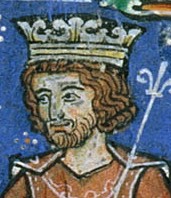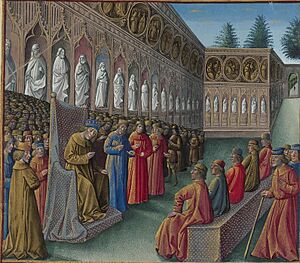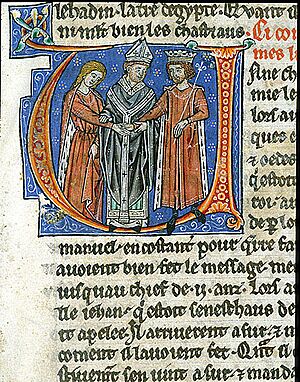Amalric of Jerusalem facts for kids
Quick facts for kids Amalric |
|
|---|---|
 |
|
| King of Jerusalem | |
| Reign | 1163–1174 |
| Coronation | 1163 |
| Predecessor | Baldwin III |
| Successor | Baldwin IV |
| Born | 1136 |
| Died | 11 July 1174 (aged 38) Jerusalem, Kingdom of Jerusalem |
| Spouse | Agnes of Courtenay Maria Komnene |
| Issue | Baldwin IV of Jerusalem Sibylla of Jerusalem Alix of Jerusalem Isabella I of Jerusalem |
| House | Anjou |
| Father | Fulk V of Anjou |
| Mother | Melisende of Jerusalem |
Amalric (born 1136, died July 11, 1174) was the King of Jerusalem from 1163 until his death. Before becoming king, he was the Count of Jaffa and Ascalon. He was the second son of Queen Melisende and King Fulk. Amalric became king after his older brother, Baldwin III, passed away.
During Amalric's time as king, Jerusalem became good friends with the Byzantine Empire. Together, they tried to invade Egypt several times, but they didn't succeed. Amalric was the father of three future rulers of Jerusalem: Sibylla, Baldwin IV, and Isabella I. Sometimes, his name is confused with another king, Aimery, but they were different people.
Contents
Early Life
Amalric was born in 1136. His father was King Fulk, and his mother was Queen Melisende. When King Fulk died in 1143, Amalric's older brother, Baldwin III, became king. Baldwin was only 13 years old.
As Baldwin grew up, he and his mother, Queen Melisende, had disagreements about who should rule. In 1152, Baldwin became the sole king. Amalric was given the County of Jaffa in 1151. He stayed loyal to his mother during this time. In 1153, Baldwin captured the Egyptian fortress of Ascalon, which was then added to Amalric's lands.
In 1157, Amalric married Agnes of Courtenay. Some church leaders didn't like this marriage because Amalric and Agnes were distant relatives. They waited until a church leader who opposed them died before getting married. Amalric and Agnes had three children: Sibylla, Baldwin IV, and Alix, who died when she was young. Sibylla and Baldwin would later become rulers of Jerusalem.
Becoming King
When King Baldwin III died in 1163, Amalric was next in line for the throne. However, some powerful nobles in Jerusalem didn't want Amalric to be king if he stayed married to Agnes. This was because of their family connection.
Amalric agreed to have his marriage to Agnes canceled. After this, he became king without a wife. Agnes still kept her title as Countess of Jaffa and Ascalon and received money from those lands. Agnes soon married Hugh of Ibelin. The church decided that Amalric and Agnes's children were still legitimate and could inherit the throne. Agnes would have a lot of power in Jerusalem through her children for many years.
Fighting Muslim States
During Baldwin III's reign, the first crusader state, the County of Edessa, was taken over by Zengi. Zengi united cities in northern Syria. His son, Nur ad-Din, later took over Damascus. Jerusalem also lost some power in northern Syria to the Byzantine Empire. Because of this, Jerusalem started to focus on Egypt. Egypt's rulers, the Fatimid dynasty, were having problems with young leaders and civil wars. The crusaders had wanted to conquer Egypt for a long time. Capturing Ascalon made it easier to try.
Invasions of Egypt
Amalric led his first trip into Egypt in 1163. He said the Fatimids hadn't paid their yearly tribute, which was a payment they owed. The Egyptian leader, Dirgham, had recently taken power. Amalric defeated Dirgham, who had to retreat. The Egyptians then flooded the land to stop Amalric from going further. Amalric went home.
Later, Dirgham was killed, and another leader, Shawar, became vizier (a high official). Shawar feared that Nur ad-Din's general, Shirkuh, would take over. So, Shawar asked Amalric for help. Amalric returned to Egypt in 1164 and surrounded Shirkuh's army until Shirkuh left for Damascus.
Amalric couldn't keep up his success in Egypt because Nur ad-Din was busy in Syria. Nur ad-Din captured some important crusader leaders. Amalric quickly went to help and arranged for one of them to be freed in 1165.
In 1167, Nur ad-Din sent Shirkuh back to Egypt. Amalric followed him again. Shawar once more joined forces with Amalric. After a battle that didn't have a clear winner, Amalric went to Cairo. Shirkuh went north and captured Alexandria. Amalric followed and surrounded Shirkuh there, with help from a fleet of ships from Jerusalem. Shirkuh agreed to peace, and Alexandria was given to Amalric. Amalric then returned to Jerusalem after getting a huge payment.
Alliance with Byzantium
After returning to Jerusalem in 1167, Amalric married Maria Comnena. She was a niece of the Byzantine emperor Manuel I Comnenus. It took two years to arrange the marriage. Amalric wanted Manuel to give Antioch back to Jerusalem, but he eventually gave up on this. They married in Tyre on August 29, 1167.
In 1168, Amalric and Manuel made an alliance to fight Egypt together. Amalric invaded Egypt without waiting for the Byzantine help. He captured a city called Bilbeis, and its people were killed or enslaved. Amalric then marched towards Cairo. Shawar offered Amalric a lot of gold. Meanwhile, Nur ad-Din sent Shirkuh back to Egypt. When Shirkuh arrived, Amalric retreated.
Rise of Saladin
In January 1169, Shirkuh had Shawar killed. Shirkuh became the new vizier, but he died in March. His nephew, Saladin, took his place. Amalric became worried and asked for help from European kings, but no help came.
Later that year, a Byzantine fleet arrived. In October, Amalric launched another invasion and surrounded the city of Damietta by land and sea. The siege lasted a long time, and people in the Christian army started to starve. Both the Byzantines and the crusaders blamed each other for the problems. A truce was made with Saladin, and Amalric went home.
Now, Jerusalem was surrounded by enemies. In 1170, Saladin invaded Jerusalem and took the city of Eilat. This cut off Jerusalem's connection to the Red Sea. Saladin became the Sultan of Egypt in 1171. Saladin's rise was a short break for Jerusalem, as Nur ad-Din was busy trying to control his powerful new vassal. Still, Amalric visited Constantinople himself in 1171 to seek help, but again, no aid arrived from Europe.
Death
Nur ad-Din died in 1174. Amalric immediately tried to capture Banias. On his way back, he became sick with dysentery. Doctors tried to help, but he developed a fever in Jerusalem. He died on July 11, 1174.
Amalric and Maria Comnena had two daughters: Isabella, born in 1172, who would later become queen, and a baby who was stillborn. Before he died, Amalric gave the city of Nablus to Maria and Isabella. Amalric's son, Baldwin IV, who had leprosy, became the next king. He brought his mother, Agnes of Courtenay, back to court.
About Amalric
William of Tyre, a historian and friend of Amalric, described him in detail. Amalric had a slight speech problem but was good at planning. He was more interested in learning than fighting. He studied law and languages in his free time. He knew a lot about the laws of the kingdom. He was probably responsible for a law that made all lower nobles directly loyal to the king.
Amalric was very curious. He enjoyed reading and having others read to him. He spent many hours listening to William read early versions of his history book. He didn't like games or shows, but he enjoyed hunting. He trusted his officials, perhaps too much. Some people didn't like him, but he didn't punish those who insulted him.
He was tall and quite handsome. He had bright eyes and a nose like his brother's. His hair was blond, and he had a full beard. He laughed a lot, and his whole body would shake. He didn't eat or drink too much, but he became very heavy in his later years, which made him less interested in military actions.
Amalric was a religious man and went to mass every day. Even though he was religious, he taxed the church, which they didn't like. William of Tyre said Amalric was "a man of wisdom and discretion, fully competent to hold the reins of government in the kingdom." He is seen as the last of the early kings of Jerusalem. A few years after Amalric died, Emperor Manuel also passed away, leaving Saladin as the strongest leader in the East.
See also
 In Spanish: Amalarico I de Jerusalén para niños
In Spanish: Amalarico I de Jerusalén para niños




